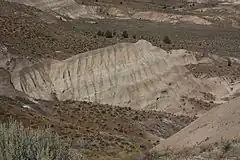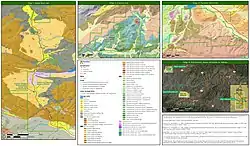Mascall Formation
The Mascall Formation is a Miocene geologic formation found along the John Day River Valley of Oregon, in the Western United States.
| Mascall Formation | |
|---|---|
| Stratigraphic range: Hemingfordian-Barstovian ~ | |
 Outcrop near Picture Gorge | |
| Type | Sedimentary |
| Underlies | Rattlesnake Formation |
| Overlies | John Day Formation |
| Area | John Day Valley, Fox Basin |
| Thickness | 2,000 feet (610 m) |
| Lithology | |
| Primary | Sandstone, conglomerate |
| Location | |
| Extent | eastern Oregon |
| Type section | |
| Named for | Mascall Ranch (south of Dayville) |
| Named by | J. C. Merriam |
| Year defined | 1901[1] |

Description
The formation is described in Geologic Formations of Eastern Oregon (1972) as follows: "The Mascall Formation consists of a maximum of 2,000 feet of fluvial sandstone, ash, light colored water-laid tuff, and well-rounded conglomerate. Within the Mascall Formation is a widespread ignimbrite unit which consists of 97 to 99 percent glass shards and minor amounts of anorthoclase, quartz, magnetite, zircon, and clinopyroxene."[2][3]
Age
The ignimbrite was radiometrically dated at 13 million years.[2] Parts of the Mascall are interfingered with the Columbia River Basalt Group.
Fossils
Barstovian vertebrates have been recovered from the Mascall.
References
- Merriam, J. C., 1901. A contribution to the geology of the John Day Basin, Oregon: Univ. Calif., Dept. Geol. Sci. Bull., v. 2, p. 269-314.
- Geologic Formations of Eastern Oregon (East of longitude 121°30'), 1972. John D. Beaulieu. Bulletin 73. Oregon Department of Geology and Mineral Industries.
- Davenport, R. E., 1970. Geology of the Rattlesnake and older ignimbrites in the Paulina Basin and adjacent area, central Oregon: Oregon State University doctoral dissertation, 132 p., unpublished.